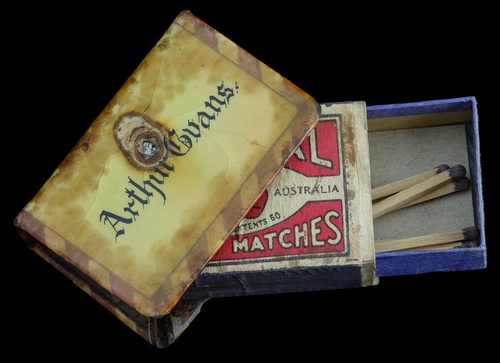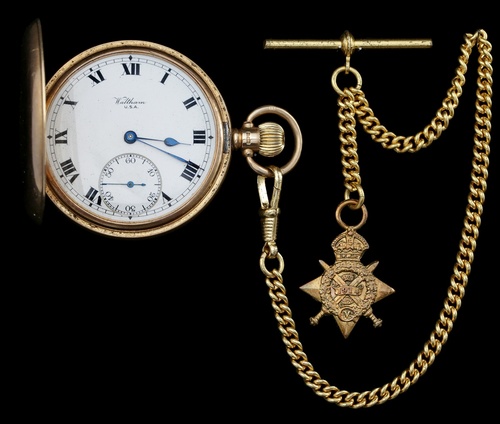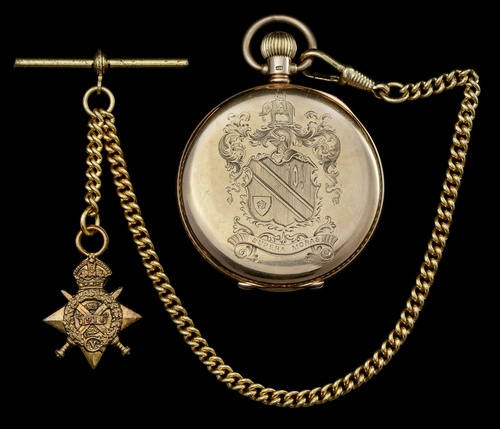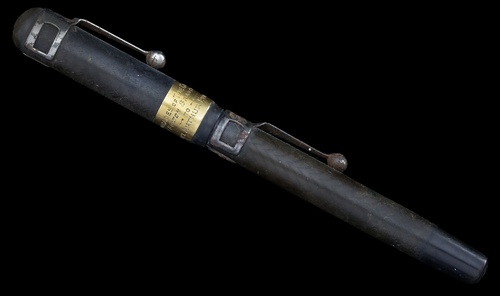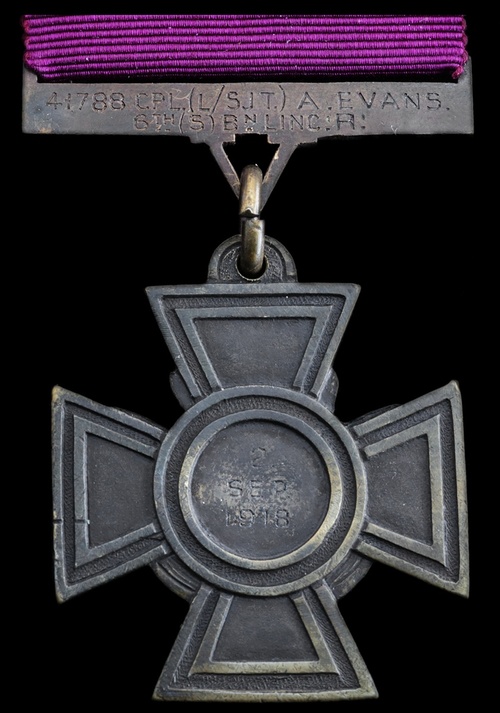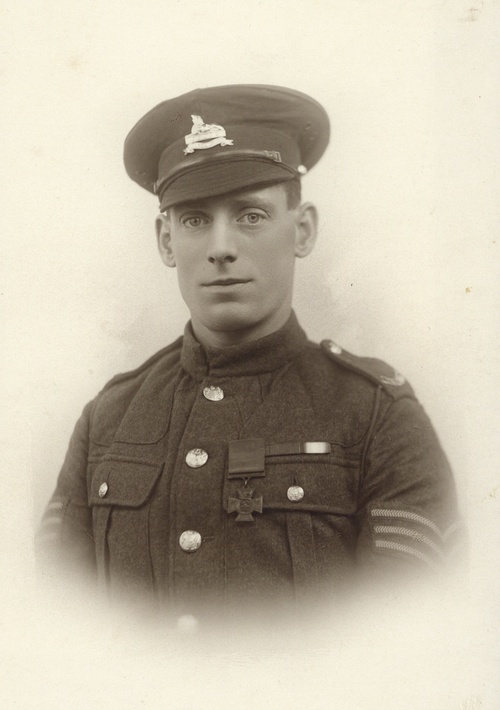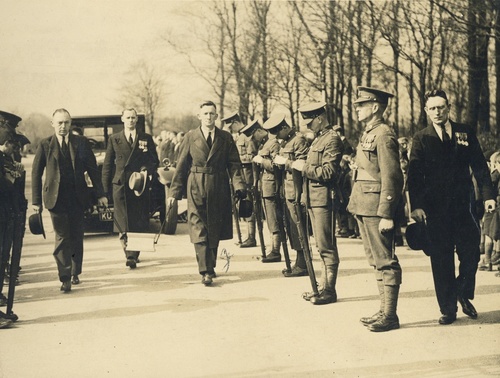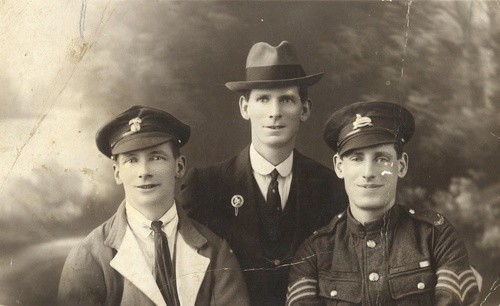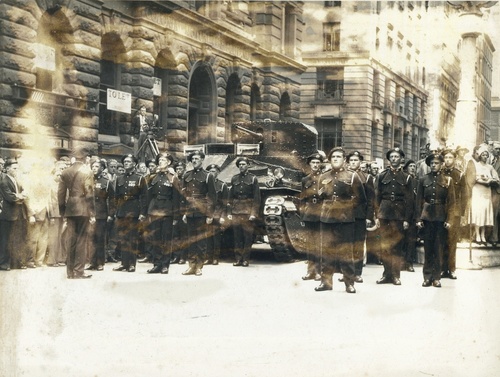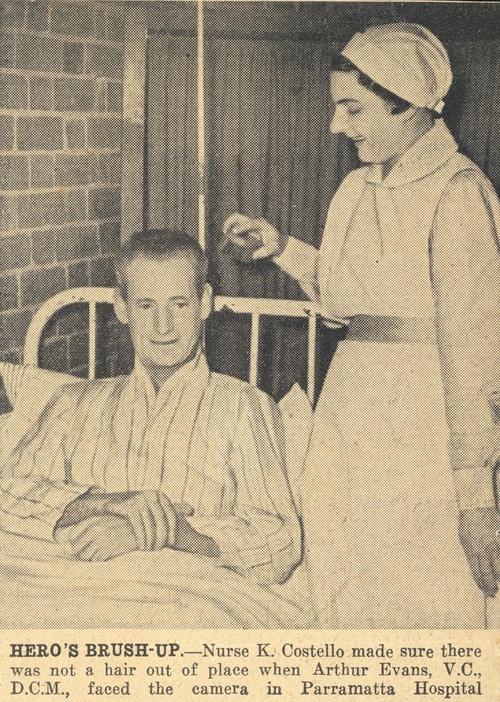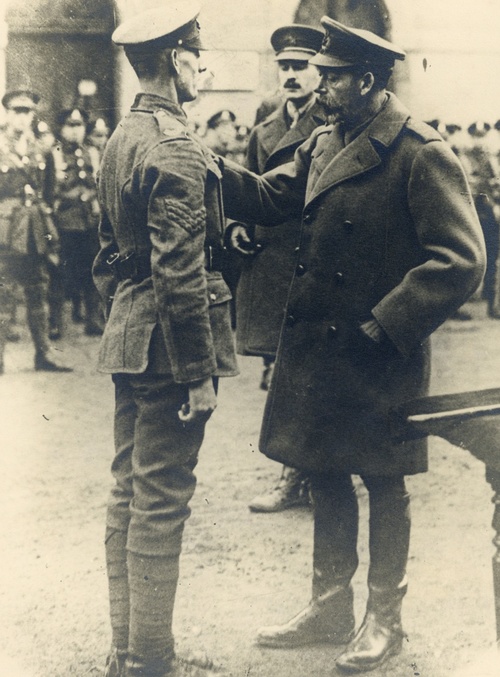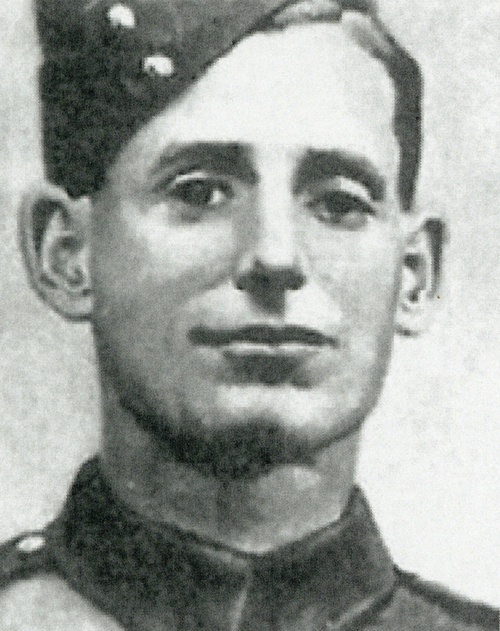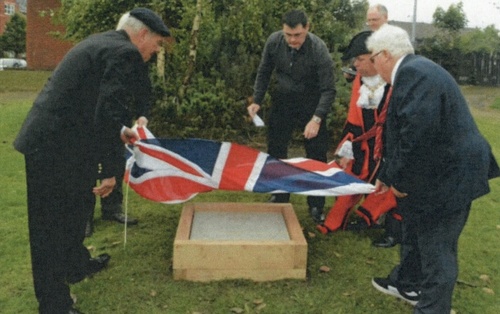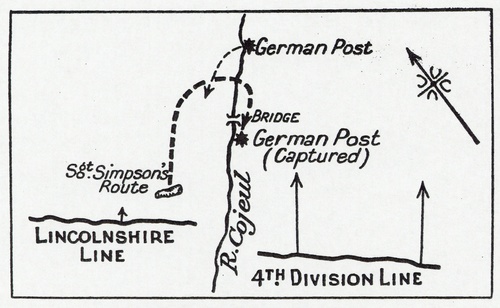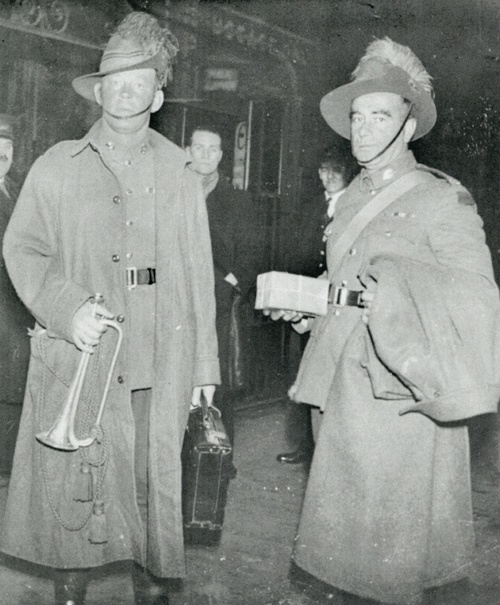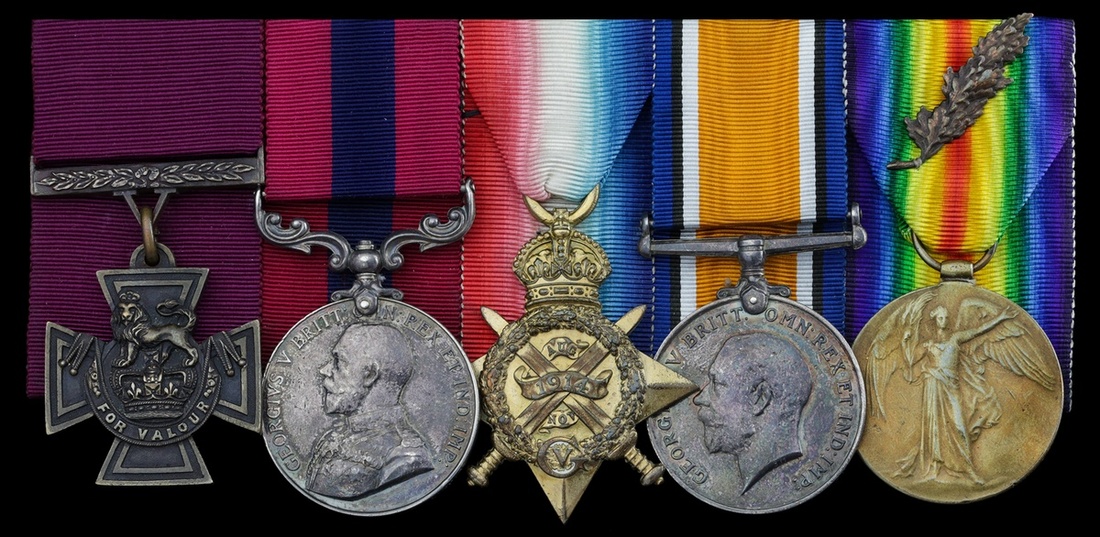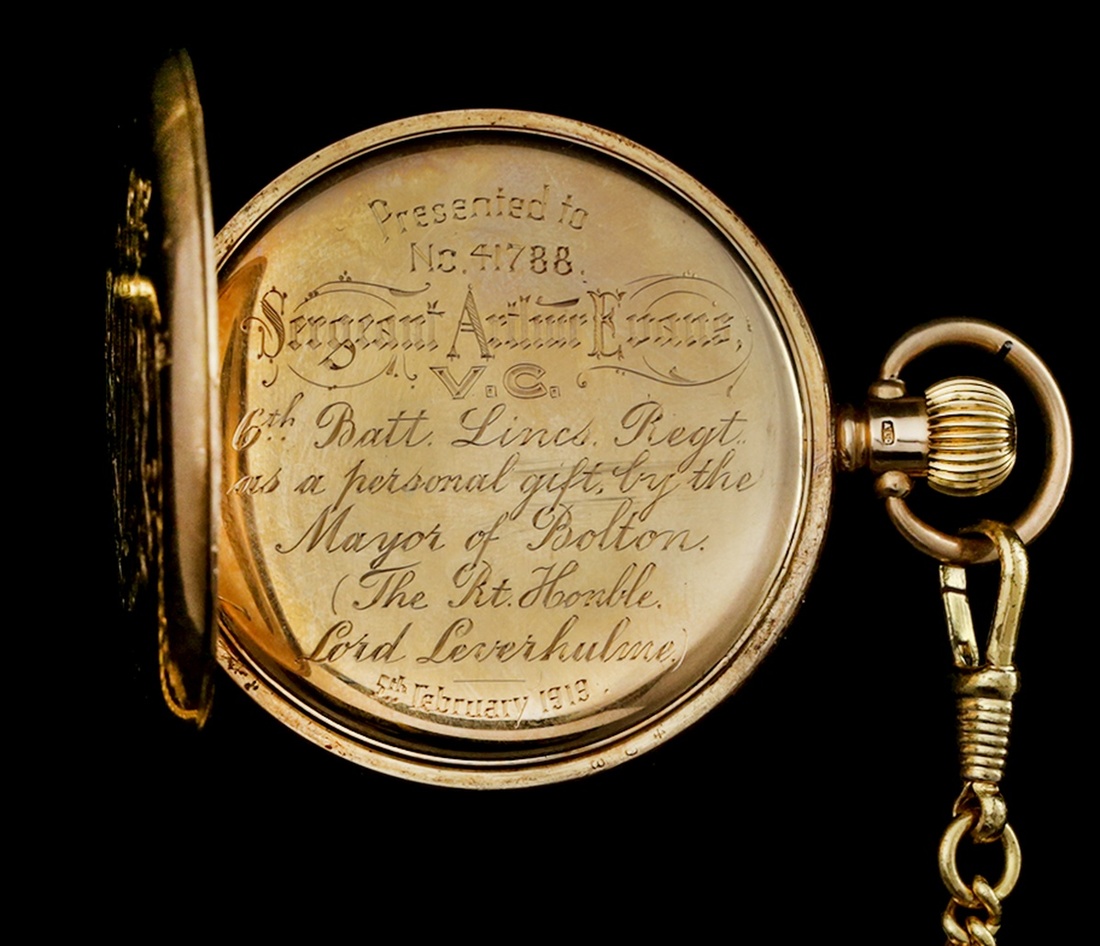Auction: 19003 - Orders, Decorations and Medals
Lot: 414
Sold by Order of a Direct Descendant
'One of the War's greatest triumphs'
General Sir A. W. 'Guts & Gaiters' Currie in his diary after the victory at Arras: it was men such as Sergeant Arthur Evans who had secured it
The outstanding 'Battle of Drocourt-Quéant Line 1918' V.C., 'Cambrai 1918' D.C.M. group of five awarded to Sergeant Arthur Evans, alias Walter Simpson, Lincolnshire Regiment, late Stoker, Royal Navy and Sergeant, King's (Liverpool) Regiment
A character of monumental proportions, his somewhat chequered career record remains full of mystery and intrigue - but his loyalty to King and Country was never in doubt
Having spent several years with the senior service Evans explored South America in his spare time, returning to Europe to see active service during the Retreat from Mons under his alias
Earning a 'mention' and being severely wounded for the first occasion with the 3rd Battalion, King's (Liverpool) Regiment, Evans deserted and re-joined the 6th Battalion, Lincolnshire Regiment - returning to the Western Front to be gassed during October 1917
Recovered (albeit after evading the call of duty for a short while) his finest hours came during the 'Hundred Days Offensive'. During this critical time the true character of Evans was illustrated not only when reacting under fire, but in his calculated, independent initiative and cold-blooded cunning in the critical moments that turned the tide of a battle
No finer example occurred on 2 September when he volunteered to swim the deep River Cojeul, stalking and rushing a well-defended enemy machine-gun post. Despatching and capturing its occupants he then provided cover and removed a wounded Officer from danger under fire-swept ground; it was considered that this individual action enabled the advance of the entire British 4th Division
Little over a month later at Cambrai he added the D.C.M. to his laurels, again personally rushing an enemy strong-point, this time accounting for 10 and capturing the sole survivor who thought it wise to disclose important intelligence rather than face Evans
Journey's end seemed to have come just days later whilst manning a machine-gun that took a direct hit from an artillery round; some higher power intervened for despite being knocked unconscious and buried by the blast, when dug out it was discovered he had been able to breathe - that stroke of luck ensured he was presented with his richly-deserved V.C. from the hands of the King and a hero's welcome back home in Bolton - their first 'son' to win the Empire's highest honour during the Great War
(a)
Victoria Cross, the reverse of the suspension bar officially inscribed '41788 Cpl. (L/Sjt.) A. Evans. 6th. (S) Bn. Linc: R:' and the reverse of the Cross '2. Sep. 1918.'
(b)
Distinguished Conduct Medal, G.V.R. (41788 Sjt. A: Evans. V.C. 6/Linc: R.)
(c)
1914 Star (11930 L. Cpl. A. Evans. 1/L'Pool R.)
(d)
British War and Victory Medals, M.I.D. oak leaves (11930 Sjt. A. Evans. L'Pool R.), mounted court-style as worn by the family, the D.C.M. and campaign medals with contact marks and pitting, very fine, the V.C. rather better (5)
V.C. London Gazette 31 October 1918:
'For most conspicuous bravery and initiative when with a daylight patrol sent out to reconnoitre and to gain touch with a neighbouring division. When on the west bank of a river an enemy machine-gun post was sighted on the east bank. The river being too deep to ford, Sjt. Simpson volunteered to swim across, and having done so crept up alone in rear of the machine-gun post. He shot the sentry and also a second enemy who ran out; he then turned out and caused four more enemy to surrender. A crossing over the river was subsequently found, and the officer and one man of his patrol joined him, and reconnaissance was continued along the river bank. After proceeding some distance machine-gun and rifle fire was opened on the patrol and the officer was wounded. In spite of the fact that no cover was available, Sjt. Simpson succeeded in covering the withdrawal of the wounded officer under most dangerous and difficult conditions and under heavy fire. The success of the patrol, which cleared up a machine-gun post on the flank of the attacking troops of a neighbouring division and obtained an identification was greatly due to the very gallant conduct of Sjt. Simpson.'
London Gazette 31 March 1919:
'The notification of the award of the Victoria Cross to No. 41788 Cpl. (L./Sjt.) Walter Simpson, 6th Bn., Linc. Regt., as announced in the London Gazette dated 3rd October, 1918, should be read as awarded to No. 41788 Cpl. (L./Sjt.) Arthur Evans, 6th Bn., Linc. Regt., the latter being the correct Christian and Surname of this N.C.O., which he has been permitted to re-assume.'
D.C.M. London Gazette 19 March 1919. Citation 2 December 1919:
'For great courage and initiative near Cambrai. He was in charge of a Platoon acting as a fighting patrol on the night of the 6th/7th October 1918, with instructions to clear the country north of the Chateau of Aubencheu-au-Bac to the Canal de la Sensee. A strong enemy post was encountered. He promptly rushed the post, killing ten, wounding several and taking one prisoner. The prisoner secured afforded most valuable information. He has shown excellent leadership and the utmost disregard of all danger.'
Note: Evans was invested with the Victoria Cross bearing the correct date but the name of the alias he had assumed. Upon being permitted to re-assume the correct identity his Cross was returned via official channels, with the incorrect suspension bar being removed and destroyed by Hancocks. A new suspension bar - that observed here - was thus engraved and applied to his Cross and returned to Evans. Research has confirmed the date of this to lie between 22 January-19 June 1919.
Arthur Evans was born at Liverpool, Lancashire on 8 April 1891, the son of Robert and Eleanor of 33 Caradoc Road, Seaforth, Litherland. Educated at St. Thomas's School, Arthur took work as a Clerk in Liverpool before his enlistment in the Royal Navy on 2 July 1909. At the rate of Stoker (K.3552), Evans served aboard Acheron, July-November 1909, briefly at Pembroke II, and finally aboard Indomitable from 17 December 1909-1 December 1910. His time during that short period included 42 days of Hard Labour and 14 days in the cells, then being discharged. Some published sources suggest he may have been injured after an accident but his Service Record states 'Services No Longer Required', noting 'Undesirable to retain in the Service. The value of any free kit + bedding to be recovered'.
Wandering soul - first foray, first wound
Evans didn't remain on terra firma for long, as recalled by VC's of the First World War: The Road to Victory 1918:
'He then decided to join the Merchant Navy and became one of the crew on a ship going to America. Once in the United States he jumped ship, and some accounts say that he was in charge on a large party of native labour which was working on the Panama Canal. After this third job he took some time off to explore parts of South America with a couple of friends, an Australian and a Scotsman, during which he suffered a fever, possibly malaria. Tiring of South America, he travelled to Cuba and then on to the USA. This time around he joined a four-masted ship which took a year to reach England, having sailed via Australia. Once back in England he joined his stepbrother and sister in their family home in Bolton. Finding that this homely life did not suit him, he joined the 1st King's Liverpool Regiment in May 1914. It was at about this time that for some reason he changed his name to Walter Simpson. He had wanted to join the RFC, but this was not to be, and instead he found himself travelling to France only a few weeks after the war had begun.'
Evans would have been amongst those men of the 1st Battalion based at Talavera Barracks, Aldershot who embarked the SS Irrawaddy, landing at La Havre in the early hours of 13 August 1914. Having entrenched at Givry on 23 August, they followed the withdrawal and ended the month at St. Bandry. Starting September in assisting the 4th (Guards) Brigade for the attack on Villers Cotterets, they finished the month at Moussy, having taken part in the attack on the Moussy Spur under heavy shell fire. October gave no respite either, for their CO, Lieutenant-Colonel W. S. Bannatyne was mortally wounded on 24 October north of Polygon Wood. It was during this attack that 'A' Company '…was brought to a standstill by a perfect hurricane of bullets.'
The remainder of the month and the start of the rest was a continued baptism of fire for Evans and his comrades, for further stints in Polygon Wood exposed them to heavy shellfire and infantry attacks. By the end of November the casualties totalled 33 officers and 814 other ranks: Evans was lucky indeed to come through unscathed (British Battalions in France and Belgium 1914, refers).
He was not so lucky to escape the trials of early 1915, but would have been present for the 'holding' attack at Givenchy, a diversion from the main British assault taking place at Neuve Chapelle. That day alone cost 61 killed, 115 wounded, and 62 missing, mainly due to uncut wire slowing the attack. Evans was wounded during May, probably at Festubert and subsequently invalided home to Manchester to recover. A 'mention' followed soon after (London Gazette 22 June 1915, refers).
Second Innings
Some uncertainty remains over the exact method for the appearance of Evans in the Lincolnshire Regiment. Published sources suggest either he simply transferred having been wounded, thus 'missing the boat' for the Middle East, whilst some say he deserted in order to avoid this fate. What is certain is that he next appears with the 6th Battalion, Lincolnshire Regiment on the Western Front in July 1916. It would have been a far from quiet assignment, for they faced the fierce fighting in capturing the Wundt-Werk and actions at Flers-Courcelette and Theipval before the year was out.
1917 saw the Battalion hotly engaged on the Ancre, before heading to Flanders for the Battles of Langemarck, Polygon Wood, Broodseinde and Poelcapelle. It seems likely that at this last engagement Evans suffered his second wound, also being gassed; on this occasion recovering in Bath. Little more needs to be said on the dreadful suffering caused by the effects of gas on both sides during the Great War but it certainly wasn't to hold back Evans in the short term.
Final Hundred Days - destiny calls
Having spent a little time at home and for an undisclosed reason in Ireland in early 1918, Evans returned to his unit in the Spring of 1918. Having borne the brunt of the German Offensive, despite giving up territorial losses, the Allies had seriously depleted the Axis ability and the final coup de grace was to be delivered over the 'Hundred Days Offensive'.
Having been hotly engaged on the Scarpe during the closing days of August, it would be on 2 September that the true tenacity of Evans came to the fore.
The Second Battle of Arras can generally be divided into two phases. Its initial phase is that of the Battle of the Scarpe, 26-30 August 1918, which resulted in over 5km of gains for the Canadian Corps and further resulted in the award of three V.C.'s. What followed was a short pause, followed by the epic Battle and capture of the Drocourt-Quéant Line. It ran between Drocourt and Quéant and was part of the system that ran from the Hindenburg Line, eleven miles west of Cambrai, northward to within seven miles west of Douai and terminated along the front east of Armentières. The system was frightening and complex, incorporating a number of mutually-supporting lines of defence, numerous fortifications including concrete bunkers, machine gun posts and heavy belts of barbed wire.
To attack such a fearsome structure, a large-scale attack was plotted. Spearheaded by Currie's 1st Canadian Division and the British 4th Division. It began early in the morning, attacking at 05.00 with support from tanks and aircraft. In twilight, the Canadian 1st Division attacked the line south-eastwards, on the extreme right, south of the Arras–Cambrai road. The Canadian 4th Division attacked in the centre between Dury and the main road and the British 4th Division attacked south of the River Sensee. It was south of Sensee that Evans and his comrades in the 6th Lincolns found themselves held up in their attack when attacking north-east up the River Cojeul. They were split from their comrades by a deep river, with a pair of well-defended German posts either side of a bridge. Evans now steps onto the stage, part of a small patrol while still daylight. He coolly saw the need for decisive, individual action. It was he alone who swam the river, stalked and took the first post, killing two and taking four more prisoner. Having been joined by an Officer and another comrade they pushed forward to reconnoitre the river bank, finding themselves under heavy fire from the second - more distant - post, amd this heavy fire wounded the Officer. In spite of the near suicidal task that faced him, Evans went across open ground in full view of the enemy and withdrew the Officer. This confirmation of the location of the second post and his taking of the first enabled the entire Division on the east bank to advance in line with the Lincolns, who had a clear path up the west bank. Evans, clearly proud of his exploits, is known to have posted his revolver home to his sister with a note stating:
'The carrier and 'it' swam the river. Its internals are getting a little rusty but perhaps Jack [brother] will oil it. Don't be afraid of it - I've extracted all its teeth!'
Having had an almost miraculous escape after being thought killed and shortly after adding the D.C.M. to his laurels, the Armistice came. Evans was subsequently presented his Victoria Cross from the hands of King George V at Vincent Barracks, Valenciennes on 6 December 1918. It was the same occasion that Commander (later Major-General) D. M. W. Beak received his Victoria Cross.
Further campaigns - crossed wires
Little consistency exists in recorded matter in relation to the next few years for Evans, although the large original archive adds much to that which is in known in print. He was given a parade in Bolton and presented to the city by the Mayor, who gave him a gold presentation pocket watch on 9 February 1919. Having dropped his alias, he was discharged in April 1919, with his campaign medals issued in November 1920.
Evans then travelled down to London and worked in the Return Room at Harrods during the January Sales, 1923 and then in the Sports Department from 16 February 1923-15 March 1924, leaving with a good reference. He had also become part of the Legion of Frontiersmen and is certainly known to have reached Australia in 1928. Some sources suggest he stayed with the Lincolnshire Regiment and then onto New Zealand, taking up a post with the Defence Department. Another suggests he was employed as a messenger for Lloyds Bank and that he stole some £500 from a safe. The case apparently came before the Wealdstone Court, with only his exemplary war record sparing him from jail. It is proposed this event triggered the move to New Zealand.
Either way, Evans and his wife set up home in Sydney in 1928, living at 'Etaing', Harris Street, Guildford. He is confirmed as having enlisted in the Australian Tank Corps, reaching the rank of Sergeant and attending the Victoria Cross Holders Dinner in 1929. Having enjoyed several happy years in the service of the Tank Corps, besides being a prominent member of the Boy Scouts and Australian Legion of Frontiersmen, his health began to fail as a result of his gassing on the Western Front. Although his suffering could not directly be attributed to an immediate illness from active service, Lord Gowrie saw to it that he would receive every treatment required. His series of letters home to England throw light on the fantastic care he was given, one example marked a 'rather special one!' by Noel Evans, of 27 June 1935, on the eve of a large 'overhaul':
'I expect you know the story of the "Ship That Found Herself" - I am now to tell you the story of another gale-battered veteran. Or perhaps a young old-timer would be more correct.
She's been getting badly knocked about by the storms of the past few years and although it would be quite wrong to decide her a useless old hulk - Lloyds would certainly not place her in the A1 category.
Therefore the experts have inspected and decided to put her into dry dock for a thorough overhaul. I understand that her bottom is to be scraped and repainted and her engines re-conditioned. It may be necessary to look at the dynamo and perhaps we will modernise her by changing over from coal to oil burners.
However when all is complete we are confident that she will be a well found ship and fit to carry the "Old Red Duster" through many a storm and over many voyages.'
Having gone under the knife, another letter of 15 July 1935 gives the outcome:
'I am still a cot-case and perhaps a bit helpless but the world in my tummy is healing nicely and the stitches were taken out yesterday. This allows me a lot more comfort. Everything continuing to go well - I hope to be allowed out of bed at the weekend. Whether this will mean that I will be able to get home or not I don't know as I am receiving some other treatment and it would be difficult to get it at home without having a competent nurse there, so, while the necessity exists I suppose I am better here.'
Despite being offered every help, Evans eventually died with his wife by his side at the Prince of Wales Hospital, aged 45, on 1 November 1936.
Evans was cremated at the North Suburbs Crematorium, with his coffin drawn on a gun-carriage through the streets of Sydney, the streets were lined by thousands of well-wishers. The Royal Australian Artillery Band preceded him and after a train journey to Rookwood he was met by members of the Australian Tank Corps, who fired volleys over his grave. Seven holders of the Victoria Cross turned out and a fund was soon established to support his widow and three- year-old son. On 1 December 1936 the 1,500-capacity Albert Dance Palais, Parramatta Road held a fundraising dance organised by Lieutenant-Colonel A. A. Brackpool.
Laid to rest - re-dedicated
Perhaps leaving some request to return to the United Kingdom, through the good offices of the Australian Government it was agreed that the ashes of Evans should travel over with the 1937 Coronation contingent. As such Gunner A. Sullivan, V.C., 'a great mate of Evans' and Trumpeter C. White sounded the Last Post and collected his ashes in Sydney. They made the journey with their precious cargo back to England and travelled by train to Liverpool to reunite his ashes with his sister. After the Loyal North Lancashire Regiment firing party had played their part, White again sounded the Last Post as Sullivan interred his ashes in Park Cemetery, Lytham-St.-Annes on 29 March 1937.
Sullivan returned to London and on 9 April was walking back to Wellington Barracks, where he was staying and stopped to sign some autographs on Birdcage Walk. In the process he slipped and knocked his head on the curb, being run over by a cyclist as he fell. He died of his injuries and his remains were given the same service that he had just provided for Evans. As a point of interest, a bronze plaque commemorating Sullivan was subsequently erected on the railings of Wellington Barracks, where it can be seen to this day.
By the 1990's the grave of Evans had fallen into some disrepair and, with the assistance of the Royal Anglian Regiment, the grave was re-dedicated in May 1992. He is further commemorated by a memorial at Rimrose Hope School, a Victoria Cross Paving Stone in Bowersdale Park, Liverpool and the naming of 'Evans Crescent' in Canberra.
Sold together with a comprehensive original archive comprising:
(i)
A gold Waltham presentation pocket watch, 15 carat, case No.130403, with hallmarks to the case, with gilt chain and a miniature dress 1914 Star affixed to the end, the outer of the watch with engraved Coat of Arms of the Mayor of Bolton, the inner with engraved dedication:
'Presented to No.41788 Sergeant Arthur Evans, V.C., 6th Batt. Lincs. Regt., as a personal gift by the Mayor of Bolton. (The Rt. Honble. Lord Leverhulme) 5th February 1919'
Together with Invitation card from the Mayor of Bolton to 'The Misses Evans', signed by Arthur, for his presentation on 5 February 1919.
(ii)
Fountain pen, with gold (18 carat) band around the cap with engraved dedication:
'Comrades of the Great War. (Bolton Branch) To Sergt. Arthur Evans, V.C., D.C.M.'
(iii)
The recipient's Anker wristwatch.
(iv)
A series of unpublished photographs of a military and personal nature, including portrait wearing his Victoria Cross, of times with the Australian Tank Corps and 'at rest'.
(v)
His Ypres League of Officers and Men Membership certificate, in the name of 'Sergt. Arthur Evans, V.C., D.C.M., Kings Liverpool Regiment.'
(vi)
A file of original newspaper cuttings and photographs related to the award of his Cross and its coverage back home.
(vii)
A file of original correspondence, letters and references related to his early career and move from Britain to New Zealand and thence Australia, with introductions from the Legion of Frontiersmen, Harrods and the Boy Scouts.
(viii)
A series of letters (14) written by Evans during his time in Australia and covering his treatment, offering a fascinating insight into his life and times.
(ix)
Pass for the Royal Visit to Australia, 1934, for the Victoria Cross Holders enclosure.
(x)
A file of original correspondence, letters and newspaper cuttings following the death of Evans. Letters of condolence include Boy Scouts Association and Returned Sailors & Soldiers' League of Australia.
(xi)
His match box, of Federal Safety Matches, still with a number of matches present, in a tortoiseshell holder, this with the name 'Arthur Evans' upon top and the badge of the Australian Tank Corps on the base.
(xii)
Assorted mixed ephemera, including Cigarette Card album, silver-gilt cigarette case, badges, buttons and a pipe. (Lot)
Subject to 20% VAT on Buyer’s Premium. For more information please view Terms and Conditions for Buyers.
Sold for
£190,000
Starting price
£120000


